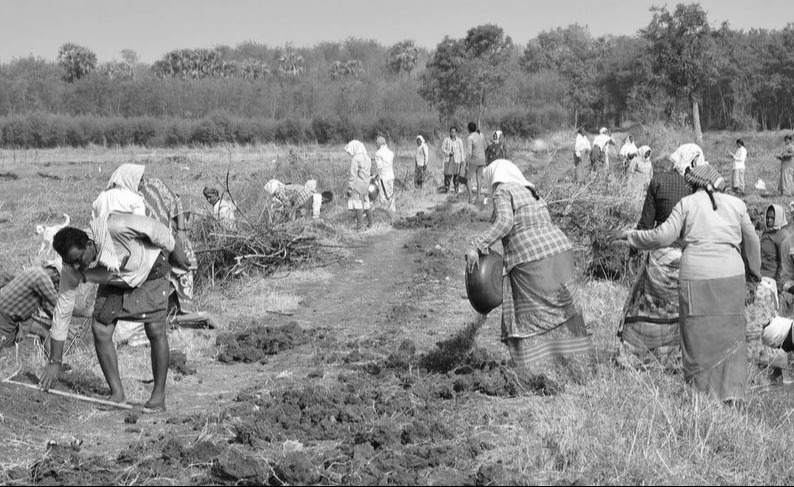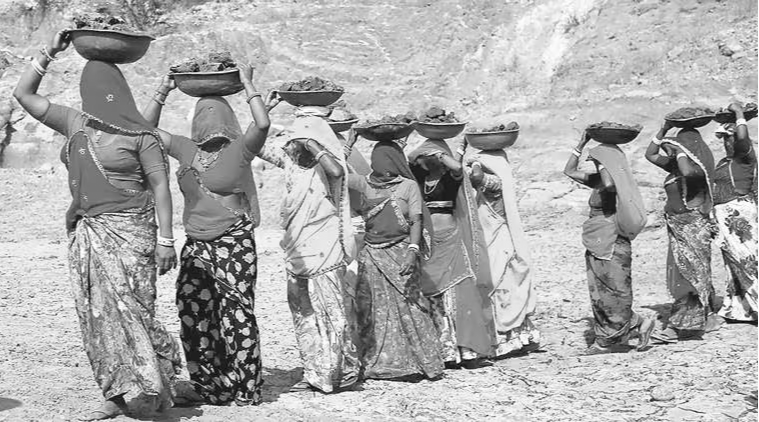
MGNREGA
"The journey from demanding minimum wages to shaping MGNREGA began in the dusty lanes of Rajasthan—led by the voices of MKSS."
🌾 The Mahatma Gandhi National Rural Employment Guarantee Act (MGNREGA)
The Mahatma Gandhi National Rural Employment Guarantee Act (MGNREGA), enacted in 2005, is one of the world’s largest social welfare programs. It guarantees every rural household at least 100 days of unskilled wage employment per year, aiming to reduce poverty, create durable assets, and curb migration to cities. Beyond wages, MGNREGA builds roads, ponds, canals, and water-harvesting structures, making it a unique blend of livelihood security and rural development. By combining employment with community asset creation, MGNREGA has become a lifeline for millions of poor households in India, especially during droughts, economic slowdowns, and crises like COVID-19.
Key Features of MGNREGA:
- Eligibility: Any adult (18+) residing in rural areas can apply for unskilled manual work. Households register with their Gram Panchayats to receive a job card, which serves as an official record of entitlement and ensures transparency in wage payments.
- Work Guarantee: The Act mandates that work must be provided within 15 days of application. If not, applicants are entitled to receive an unemployment allowance, making this a legally enforceable right and holding authorities accountable to rural citizens.
- Wages: Workers are paid according to state-specific minimum wage rates, with strict provisions for equal pay for men and women. Payments are credited directly into workers’ bank or post-office accounts, reducing corruption and ensuring financial inclusion in rural areas.
- Types of Work: Projects focus on community development such as water conservation, irrigation canals, rural road construction, afforestation, and land improvement. These works not only generate employment but also create durable assets that benefit future generations and local economies.
- Transparency and Accountability: The Act is closely linked with the RTI Act, allowing citizens to access key records like muster rolls, job cards, and expenditure details. Social audits conducted by villagers themselves further ensure public scrutiny and reduce corruption.
- Funding: MGNREGA is jointly financed by the central and state governments, with the center covering wages and most material costs. This shared responsibility ensures stable funding while encouraging state-level commitment to proper planning, execution, and accountability.
Objectives:
- Provide a social safety net for rural poor by guaranteeing wage employment, reducing economic vulnerability, and offering relief during lean agricultural seasons or natural calamities.
- Empower marginalized groups, especially women, Scheduled Castes, and Scheduled Tribes, by ensuring equal access to work opportunities, promoting dignity, and enhancing community participation in decision-making.
- Strengthen rural infrastructure and natural resource management through durable assets like ponds, canals, check dams, and soil-moisture conservation structures, ensuring long-term benefits for farming communities.
- Promote inclusive growth and reduce rural-urban migration by creating livelihood opportunities within villages, improving living standards, and keeping families together in their home communities.
Impact of MGNREGA:
- Employment Reach: Every year, over 11 crore households benefit from MGNREGA, making it the largest public works programme globally. Its wide reach ensures rural families have access to much-needed income during lean seasons.
- Women’s Participation: More than 50% of participants are women, giving them financial independence, decision-making power, and recognition as key contributors to rural economies.
- Asset Creation: Millions of rural projects such as ponds, check dams, irrigation canals, and rural roads have been built, improving water security, connectivity, and agricultural productivity across villages.
- Poverty Reduction: By providing steady wages and preventing migration, MGNREGA acts as a safety net, reducing extreme poverty and helping families cope during crises like droughts or pandemics.
- Local Economies: Wages paid under the scheme are spent locally, boosting rural markets, improving consumption, and strengthening small-scale village businesses and agriculture-related services.
Challenges of MGNREGA:
- Delayed Payments: Wage disbursements are often delayed due to bureaucratic inefficiencies and late release of funds, discouraging participation and creating hardship for workers dependent on timely income.
- Corruption and Leakages: Ghost job cards, inflated muster rolls, and diversion of funds remain challenges, even though social audits and RTI help reduce malpractice in implementation.
- Low Wages: In many states, the wages under MGNREGA are below market rates for similar work, lowering its attractiveness compared to private sector labor opportunities.
- Asset Quality: Some projects lack proper technical planning or maintenance, resulting in weak or short-lived community assets that fail to deliver long-term benefits.
- Administrative Gaps: Gram Panchayats are often under-staffed and lack capacity to plan, supervise, and maintain records, leading to inefficiencies in execution.
- Excess Demand: During droughts or economic crises, demand for employment exceeds the guaranteed 100 days, leaving households without sufficient livelihood support in their most critical times.


Implementation Process:
RTI and MGNREGA The Right to Information Act plays a crucial role in making MGNREGA accountable. Citizens can file RTIs to access muster rolls, wage payment details, or project expenditures. Such transparency has exposed fake job cards, inflated bills, and diversion of funds. For example, in Rajasthan, activists used RTI to uncover ₹50 crore misappropriated in 2023. Workers also use RTI to verify wage credits and claim pending payments. NGOs train communities to file RTIs, strengthening grassroots accountability. While some officials resist by delaying or denying data, appeals and social audits ensure that corruption is harder to hide, improving delivery of benefits.
Recent Developments (as of July 2025):
In the 2024-25 Union Budget, ₹86,000 crore was allocated for MGNREGA. However, rising rural distress has sparked debates about expanding work guarantees to 150 days, especially in drought-affected regions. New technology like GPS-based attendance is being piloted to curb fake entries, though Aadhaar-linked payments have caused problems for workers lacking proper documentation. Increasingly, projects focus on climate resilience, such as watershed management and afforestation, aligning with sustainability goals. Despite these innovations, protests over delayed payments and low wages remain frequent. Social media discourse reflects both MGNREGA’s vital role and its ongoing struggle for adequate funding and efficiency.
RTI’s Role in Strengthening MGNREGA:
Socio-Economic Impact MGNREGA has far-reaching social and economic impacts. By reducing migration, it keeps families together and strengthens village communities. Wage inflows increase rural demand, benefiting local shops, services, and agriculture. The program also empowers women by ensuring equal wages and providing childcare facilities at worksites. For marginalized groups, MGNREGA is often the first step toward financial independence and dignity. Critics argue that it diverts labor from agriculture or fosters dependency, but evidence shows it complements farm incomes and builds resilience. Overall, MGNREGA acts as both a poverty-reduction strategy and a development tool, reshaping India’s rural landscape.
Socio-Economic Impact:
- Migration Reduction: MGNREGA has slowed distress migration by providing local employment, especially during agricultural off-seasons.
- Economic Multiplier: Wages boost local economies, increasing demand for goods and services in rural markets.
- Criticism: Some argue MGNREGA creates dependency or diverts labor from agriculture, though studies show it complements farm income.